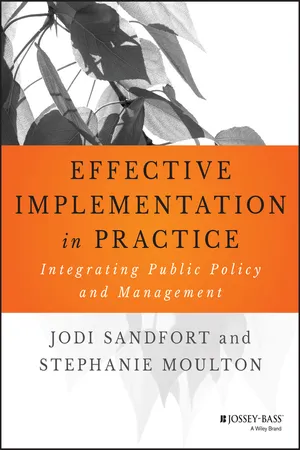
Effective Implementation In Practice
Integrating Public Policy and Management
- English
- ePUB (mobile friendly)
- Available on iOS & Android
Effective Implementation In Practice
Integrating Public Policy and Management
About this book
A unique approach to policy implementation with essential guidance and useful tools
Effective Implementation in Practice: Integrating Public Policy and Managemen t presents an instrumental approach to implementation analysis. By spanningpolicy fields, organizations, and frontline conditions in implementation systems, this book provides a robust foundation for policy makers, public and nonprofit managers and leaders. Detailed case studies enable readers to identify key intervention points, become more strategic, and improve outcomes. The engaging style and specific examples provide a bridge to practice, while diagrams, worksheets, and other tools included in the appendix help managers apply these ideas to team meetings, operational planning, and program assessment and refinement.
Policy and program implementation is fraught with challenges as public and nonprofit leaders juggle organizational missions and stakeholder expectations while managing policy and program impact and effectiveness. Using their own experience in practice, teaching, and research, the authors empower policy and program implementers to recognize their essential roles within the workplace and help them cultivate the analytical and social skills necessary to change.
- Understand how program or policy technology constitutes the core of implementation
- Study a conceptual framework encompassing power dynamics, culture, relationships in the field and the rules that are operating during program and policy implementation
- Discover a multilevel approach that identifies key points of strategic action at various levels and settings of the implementation system and assesses implementation success
The integration of policy and management mindsets gives readers an insightful yet accessible understanding of implementation, allowing them to achieve the potent results desired by the public. For those in senior positions at federal agencies to local staff at nonprofit organizations, Effective Implementation in Practice: Integrating Public Policy and Management provides an invaluable one-stop resource.
Frequently asked questions
- Essential is ideal for learners and professionals who enjoy exploring a wide range of subjects. Access the Essential Library with 800,000+ trusted titles and best-sellers across business, personal growth, and the humanities. Includes unlimited reading time and Standard Read Aloud voice.
- Complete: Perfect for advanced learners and researchers needing full, unrestricted access. Unlock 1.4M+ books across hundreds of subjects, including academic and specialized titles. The Complete Plan also includes advanced features like Premium Read Aloud and Research Assistant.
Please note we cannot support devices running on iOS 13 and Android 7 or earlier. Learn more about using the app.
Information
Part One
The Implementation Landscape
Reformers are institutional gardeners more than architects and engineers. They reinterpret codes of behavior, impact causal and normative beliefs, foster civic and democratic identities and engagement, develop organized capabilities, and improve adaptability.1
The great thing about [gardening] is the way something new is always happening . . . Each year there are new varieties to discover in the annual crop of seed catalogs, new trends to dabble with and new planting schemes to explore. And apart from the dazzling variety of the plants themselves, there are the imponderables of pests, problems and weather that combine to make each season a new gardening adventure. But some things never change—the basic skills of sowing, planting, and cultivation.2
Notes
Chapter One
Framing Implementation
Box 1.1 Overview of National Health Care Reform
Table of contents
- Essential Texts for Public and Nonprofit Leadership and Management
- Title Page
- Copyright
- Tables, Figures, and Boxes
- The Authors
- Dedication
- Preface
- Part One: The Implementation Landscape
- Part Two: The Implementation System at Multiple Levels
- Part Three: The Practice of Effective Implementation
- Appendix A: Policy Field Audit
- Appendix B: Policy Field Visual Diagram
- Appendix C: Program Process Flow
- Appendix D: Organization Program Integration Audit
- Appendix E: Frontline Interactions Audit
- Appendix F: Target Experiences Analysis
- Appendix G: Implementation Dynamics and Outcomes Analysis
- Appendix H: Implementation Improvement Blueprint
- Bibliography
- Index
- End User License Agreement